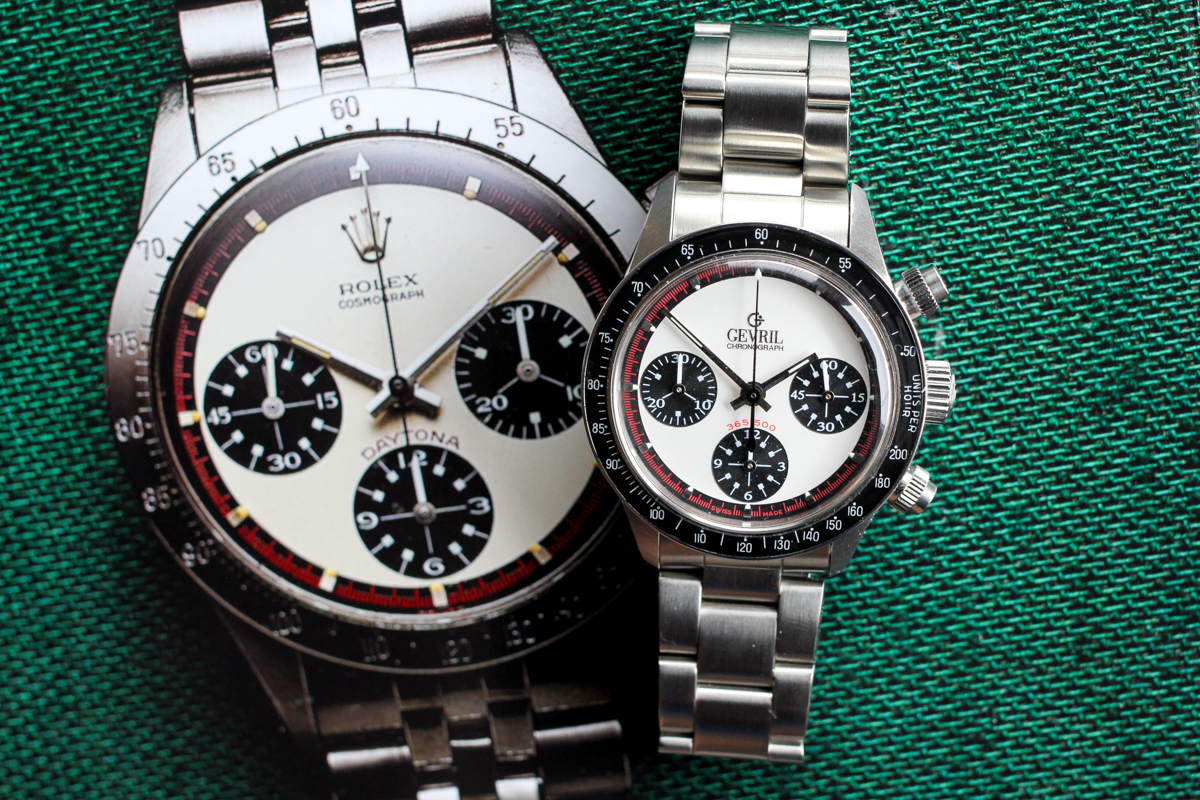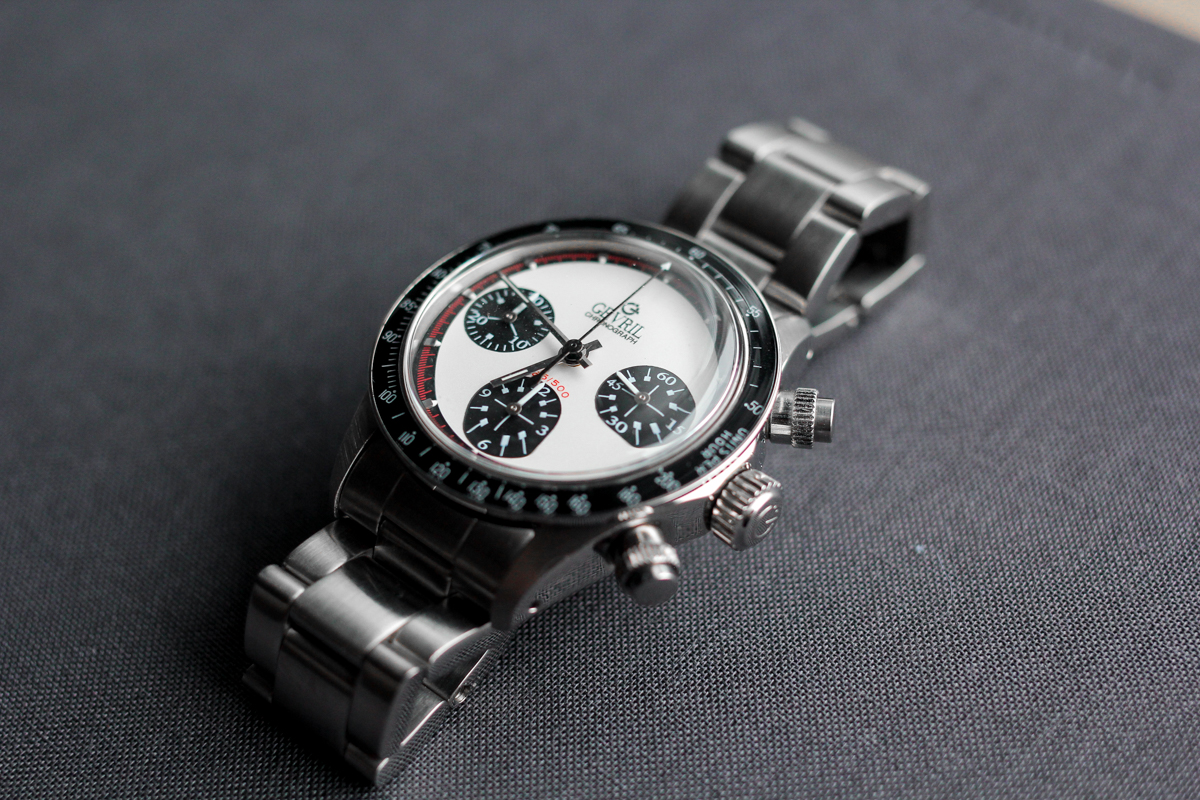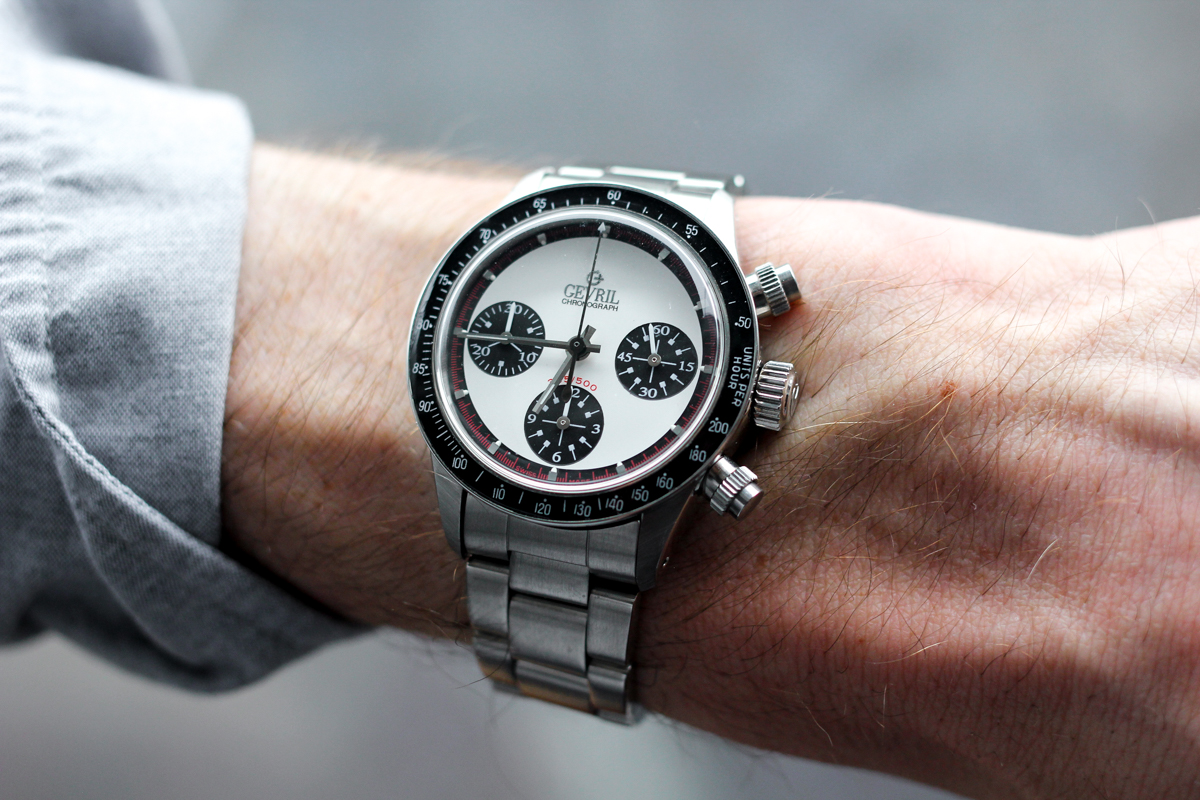It’s time to tackle one of the most polarizing topics to hit the mainstream watch world in the past few years: the Gevril Tribeca. How are we, connoisseurs and defenders of the art of horology, supposed to react to the greatest homage watch ever made? The only real coverage of these oddities seems to come from two opposite ends of the spectrum: (i) owners or dealers who are hoping to influence their corner of the market (“They’re JUST like a Paul Newman, I swear!”), and (ii) dyed in the wool Rolex collectors who have spent small fortunes on legitimate Paul Newman Daytonas (“The Gevrils are an abomination to watchmaking and should be wiped off the face of the earth!”). The truth, however, lies somewhere in between.
When Revolution helped to “re-release” the Tribeca in April, I have to admit that I was intrigued. The stories of the Tribeca had been around for quite some time, but really began picking up steam after John Mayer’s acknowledgment that it was okay, nay, cool to wear an homage watch. Later, Theo & Harris added one to their shop and put out editorials and a YouTube video about the virtues of the Tribeca. The final layer of public exposure came via an appearance on Talking Watches, of all places, courtesy of Keegan Allen. By the time Revolution paired up with the current incarnation of Gevril, the Tribeca had become something that was truly sought after in its own right…but should it be? We’ll get to that.

I like to think that my “rental” of the Tribeca was purely for journalistic purposes. I never had delusions of passing a Gevril down to my son one day, but I was curious to know what it was like in the metal. I also own a 6239 Daytona and have handled plenty of Paul Newman Daytonas over the years, so I felt qualified and neutral enough to give it a go. There was only one problem…by the time I decided to actually purchase the watch, Revolution’s online shop was sold out (further validating the “arrival” of the Tribeca). Rather than giving up, I tossed a Hail Mary and reached out to the current ownership of Gevril, who amazingly had one example remaining with the only dial and bezel combination I wanted. It was trial time.
Even though I knew the watch was essentially a loaner, I felt oddly excited when the FedEx box was delivered to my office. The packaging was nicely done and included a wooden outer display box and full paperwork. And then there was the watch itself. Upon first glance, the aforementioned conflict was well-founded – if you’re casually wrist-checking a stranger from a short distance, it would be very hard to tell that the Gevril isn’t an actual Paul Newman Daytona. The case diameter is the same (37mm), though the lugs are tapered ever so slightly differently. The bezel is truly a copy/paste exercise and the dial is also well made, with fine printing and faithful adherence to the actual Paul Newman dials. Take a second to scroll back up to the top to compare against the header and you’ll see that the two lines of text, applied logo, red text above the hour counter, outer minute track, and lume plots all faithfully adhere to the actual Paul Newman dial.
The Tribeca also features an ETA 2824 with Dubois Depraz chrono module, which is commonly used by high-end Swiss brands such as Audemars Piguet, Omega, and JLC, and furthers the narrative that Gevril’s original intention was to honor the Daytona and create a substantive watch, rather than an attractive mirage. I had to admit…for ~$3K, it was a hell of a package. So with all of that said, why buy a Paul Newman if you can buy a Tribeca for about 2% of the price? Yeah, let’s get to that.

My time as a Tribeca owner lasted slightly over two weeks, and I found a near-linear decrease in my interest over that period. I joyfully wore the Tribeca for the first two days after receiving it, but as the cumulative toll of my nit-picking started to pile on, I switched from wearing it all day, to wearing it for maybe an hour or two around the house over the next week, and finally, not at all. It’s hard to imagine the Gevril being topped by another homage watch, but the Tribeca is ultimately just that: a tribute to a legendary chronograph, and not a legendary chronograph itself. I mentioned all of the things that Gevril got right with the Tribeca, but I have a number of nits to pick with the watch as well:
- The Bracelet: Despite what you may have read in certain places, no, the bracelet is not a suitable substitute for a legitimate Rolex Oyster bracelet. In fact, it was probably my biggest gripe with the total package, as the polishing on the edges was somewhat cheap looking and brushing was not precise. It’s not the worst bracelet ever made, but it falls well short of the original Oyster, not to mention similar bracelets on watches in the sub-$3K market. Additionally, the end links’ fit was imperfect and the bracelet would often “clink” when flexing the wrist.
- Fit and Finish: The Tribeca actually wears quite similarly to vintage Daytonas and I could find little fault in the faithfulness of its proportions, which is typically the most basic thing that homage watches get horribly wrong (due to manufacturing cost restrictions). Similar to the bracelet, however, the case polishing and brushing is not as precise as true high-end pieces and if you’re used to that standard, it’s hard not to notice. Finally, if you’ll allow me to be picky, the screwdown pusher threads aren’t nearly as tight as Rolex pushers. I admit the screwdown action is an obsessive nit, but perfection in the smallest details is what makes Rolex…well, Rolex.
- The Logo: Look, I’m not a snob. I promise. I love watches in all shapes, sizes, and from a wide range of manufacturers. With that said, the Gevril logo is just bad (it looks like a tilted power button?) and unfortunately, it’s prominently displayed where the almighty crown would be on the Daytona.
- Black-Dialed Tribecas: It’s worth noting here that the black-dialed variants of the Tribeca are farther off the mark than the white dials. If you compare the black Tribeca to a 6239 Paul Newman, you’ll notice that the Gevril has a glossy, silver sheen to the sub-dials and noticeably inferior print quality. Oddly, this issue doesn’t exist (at least to that degree) with the white-dialed variants.
- The Small Things: As a vintage chronograph lover, I would have loved to see a manually winding column wheel chronograph movement under the hood. While not necessarily a “fault” of the Tribeca, its movement dictates that the second and minute counters are reversed relative to a Valjoux 72 movement, and to a collector who owns an actual Daytona, it’s yet another reminder of what the Tribeca isn’t.

As I reflect on my time with the watch, I think I’ve figured out the perfect advice for a few different types of potential buyers. Refer to the scenarios below if you find yourself grappling with the decision to purchase the Gevril:
- You own a vintage Daytona or Monte Carlo chronograph: Steer clear of the Tribeca and head for open water, Big Tuna. The small deficiencies will eventually make you realize that you’re better off just wearing the real thing, and while you may think it’s a “fun” piece to throw around, I guarantee that it will end up languishing in your watch box. Save the money and hassle.
- You have 1-2 watches and less than $5K to spend on the next watch: Don’t buy it. Gevrils could be snatched up for less than $1,000 just a few years ago, but like anything else in this hobby, as awareness has increased, the prices have surged to $3,500-4,000. At that price point, there are a handful of far superior offerings from prestigious brands (eh hm, the Black Bay 58).
- You constantly buy / sell low-to-moderately priced watches and are in it for fun: You are the ideal modern target market for the Gevril Tribeca! If you haven’t spent significant time with a vintage Daytona and don’t worry about value creation from your watches, it’s perfect. I believe they will always be sought-after watches in the $2-4K range and they’re certainly a conversation starter at any get-together.
I’ll leave you with this: the Gevril Tribeca is simply about having fun, and the moment you start to take the watch too seriously in its own right, it loses the very appeal that made it well-known in the first place. It’s not a Daytona and it never will be. And that’s okay.







